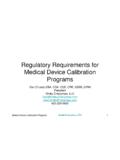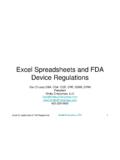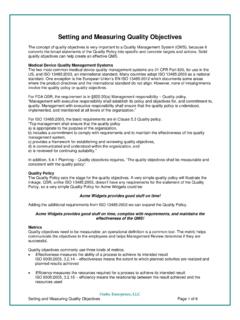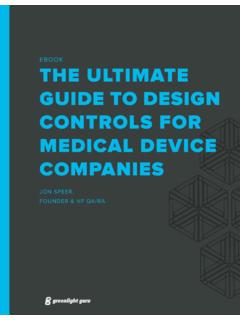Transcription of Setting the Medical Device Lifetime - Ombu …
1 3 Forest Ave. OMBU ENTERPRISES, LLC Swanzey, NH 03446 Phone: 603-209-0600 E-mail: Setting the Medical Device Lifetime Medical Device manufacturers face an issue in Setting the Lifetime of a Device . Principally, the Lifetime , in a Medical Device QMS, sets the record retention period. There are considerations for risk management as well. Every Device manufacturer must set a Lifetime for each Device , but the regulations don t provide much guidance. Record Retention FDA In the FDA regulations, the Lifetime of a Device sets record retention periods. The concept of service life is not considered. The only definition is in the MDR regulations, Expected life of a Device means the time that a Device is expected to remain functional after it is placed into use. Certain implanted devices have specified "end of life" (EOL) dates.
2 Other devices are not labeled as to their respective EOL, but are expected to remain operational through activities such as maintenance, repairs, or upgrades, for an estimated period of time. The draft QSR defined End of life but FDA deleted it from the final version. In QSR, (b) says, All records required by this part shall be retained for a period of time equivalent to the design and expected life of the Device , but in no case less than 2 years from the date of release for commercial distribution by the manufacturer. In (c), on Medical Device reporting, we find, If you are a manufacturer or importer, you must retain an MDR event file relating to an adverse event for a period of 2 years from the date of the event or a period of time equivalent to the expected life of the Device , whichever is greater. In (c), on corrections and removals, the requirement is, The manufacturer or importer shall retain records required under this section for a period of 2 years beyond the expected life of the Device , even if the manufacturer or importer has ceased to manufacture or import the Device .
3 The draft UDI regulations are an exception, since the UDI reflects the Device configuration (version or model), not end of life. Proposed (a) requires, Each labeler shall retain, and submit to FDA upon specific request, records showing all unique Device identifiers (UDIs) used to identify devices that must be labeled with a UDI, and the particular version or model associated with each Device identifier. These records must be retained for 3 years from the date the labeler ceases to market the version or model. Ombu The Operational Excellence Company Setting the Medical Device Lifetime Page 1 of 3 Record Retention ISO 13485:2003 The record retention theme continues in this international standard. Clause requires retention a copy of obsolete controlled documents for at least the Lifetime of the Medical Device as defined by the organization, but not less than the retention period of any resulting record.
4 Clause requires retention of records for the Lifetime of the Medical Device as defined by the organization, but not less than two years from the date of product release. Lifetime Advice ISO/TR 14969:2004 ISO/TR 14969:2004 Medical devices Quality management systems Guidance on the application of ISO 13485:2003, clause offers advice on Setting the Lifetime of a Device . The guidance recommends documenting the defined Lifetime of the Medical Device as well as the rationale for determining the Lifetime . Some considerations in the determination include: shelf life of the Medical Device expiration date of the Device or its components the number of cycles or periods of use of the Medical Device anticipated material degradation stability of the packaging material for implantable devices , the residual risk that results from the entire period of residence of the Device inside the patient s body for sterile Medical devices , the ability to maintain sterility the organization s contractual or regulatory obligation to support and service the Device spare parts cost and availability.
5 Legal considerations including liability Risk Management Considerations The defined product Lifetime can help control residual risks that can increase to unacceptable levels over extended Device periods of ISO 14971:2003 Clause define the Device life-cycle as all phases in the life of a Medical Device , from the initial conception to final decommissioning and disposal. The Risk Management Plan needs to include the scope of the planned risk management activities, identifying and describing the Medical Device and the life-cycle phases for which each element of the plan is applicable. Because risks appear throughout the product life-cycle, the life-cycle definition is important. Risks that appear at one point in the life-cycle may be managed by action or controls at a different point. This argues for the application of risk management throughout the life-cycle from design to disposal.
6 Recommendations As part of the Quality Management System (QMS), define the life of each Device . Start in design Control, by applying the principles from ISO/TR 14969:2004. Document your consideration and decision in the design History File (DHF). Ombu The Operational Excellence Company 1 ISO/TR 14969:2004, Clause Setting the Medical Device Lifetime Page 2 of 3 Through design Transfer, (h), document the decision in the QMS. Since it is Device specific, you could include it in the Device Master Record (DMR), A better place, however, is the Quality System Record (QSR). Collect all of the Lifetime decisions and rationale in one document. Maintaining it in the QSR means that there is only one place to look, instead of needing to check multiple DHRs. As part of your Risk Management System (RMS), include your decisions on the life-cycle and Device Lifetime in the Risk Management Plan, which becomes part of the Risk Management file.
7 Link the production and post-production information RMS activities to the defined Device Lifetime document in the QSR. As part of your internal quality audit program, verify the ability to retrieve documents and records that are near the end of the record retention period. Ombu The Operational Excellence Company Setting the Medical Device Lifetime Page 3 of 3













